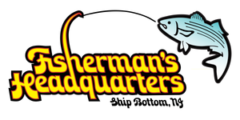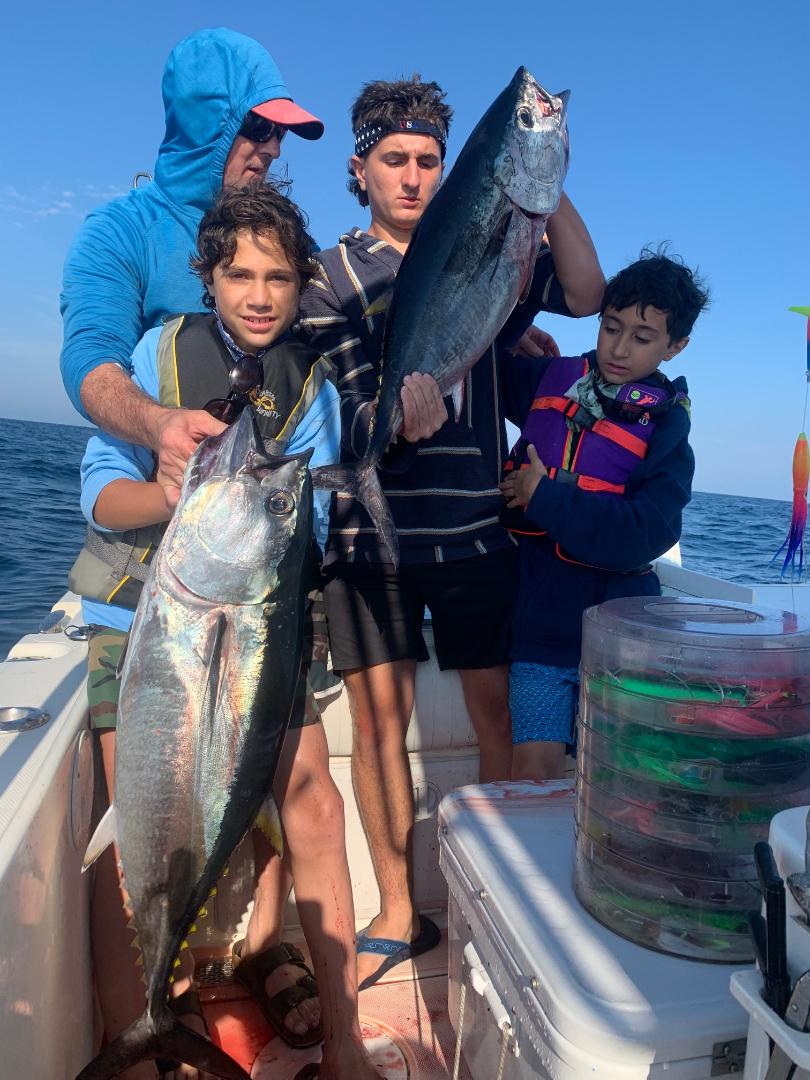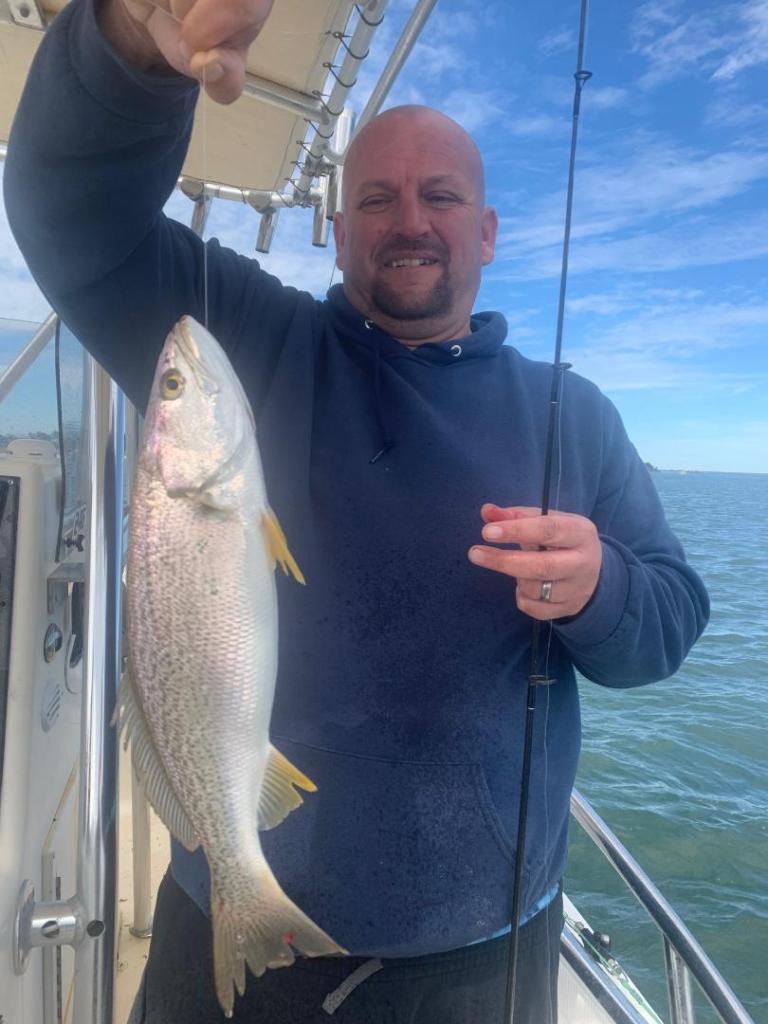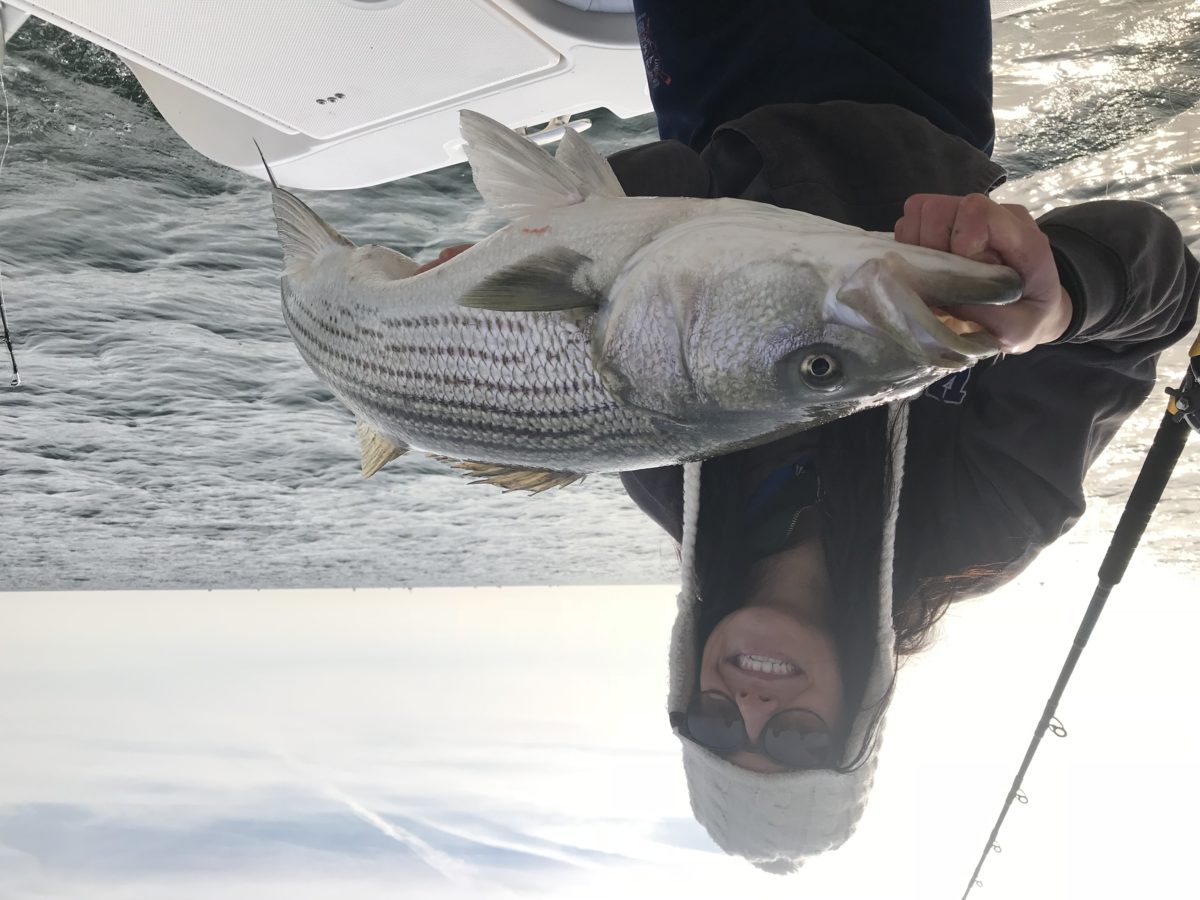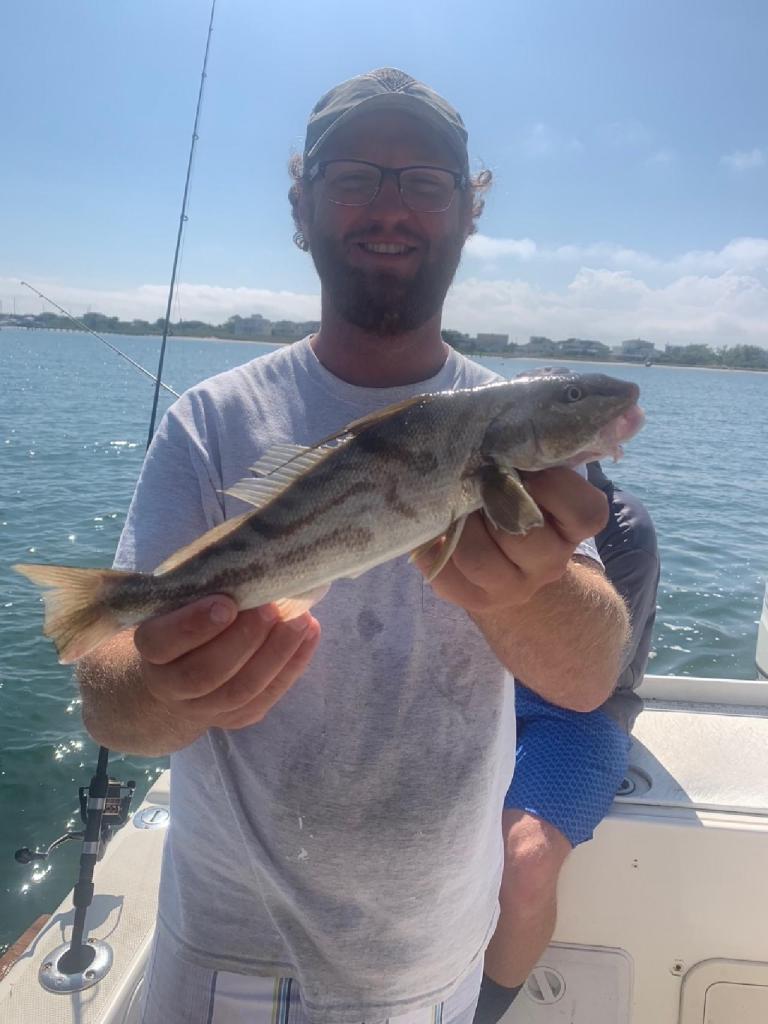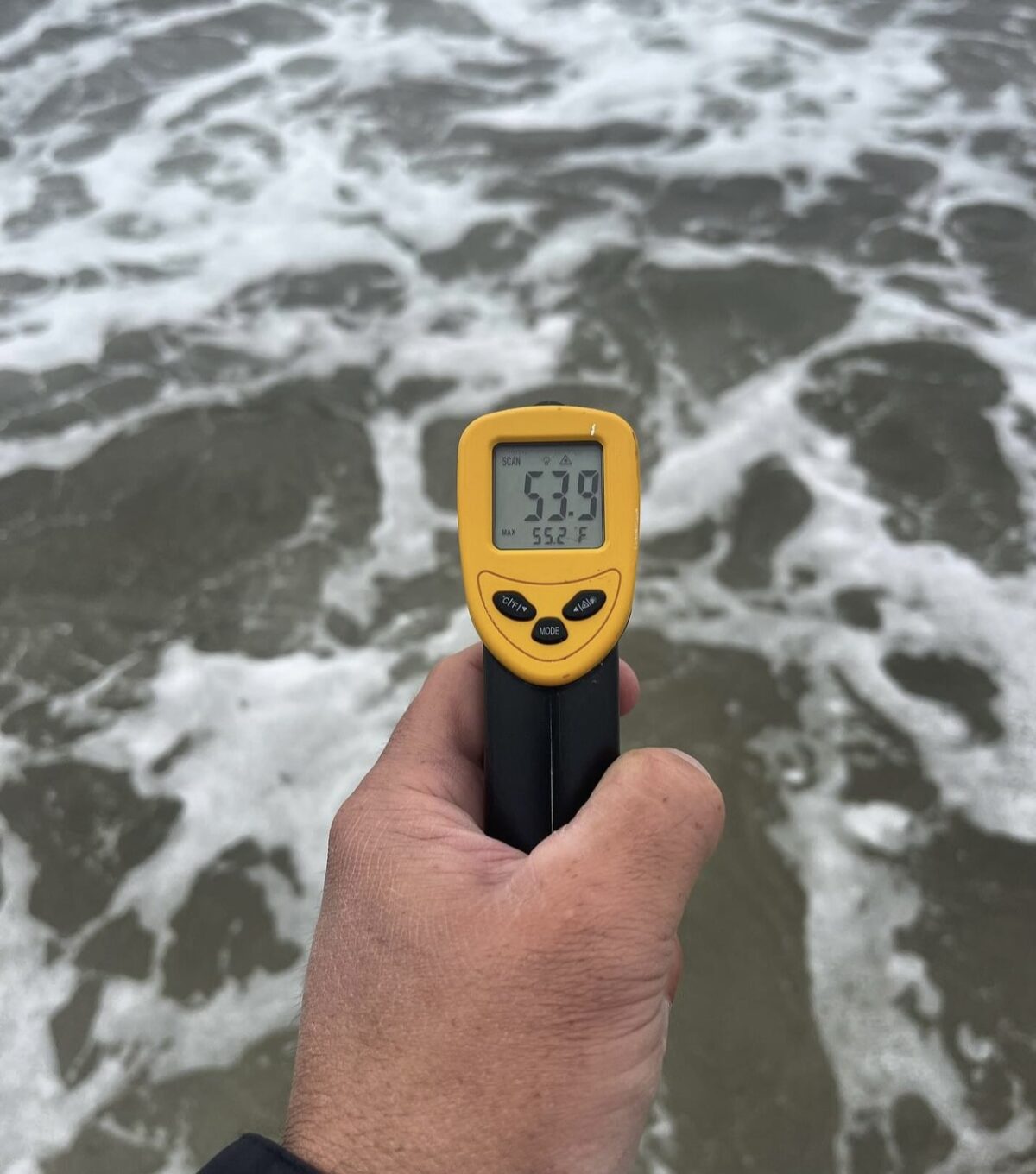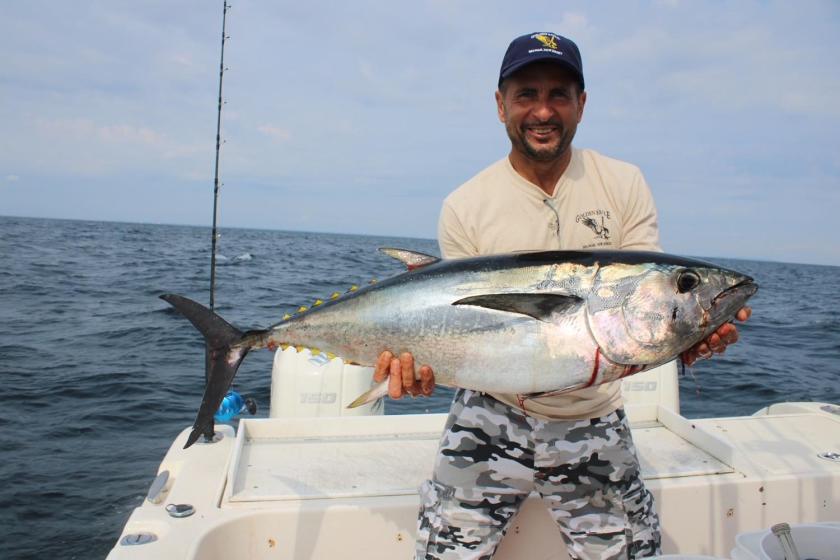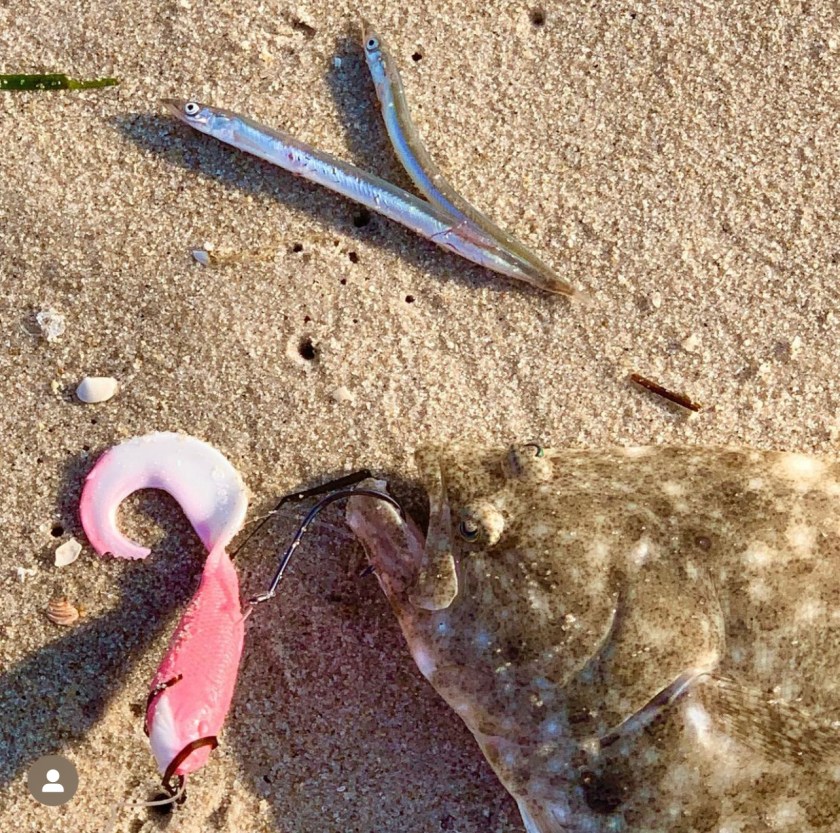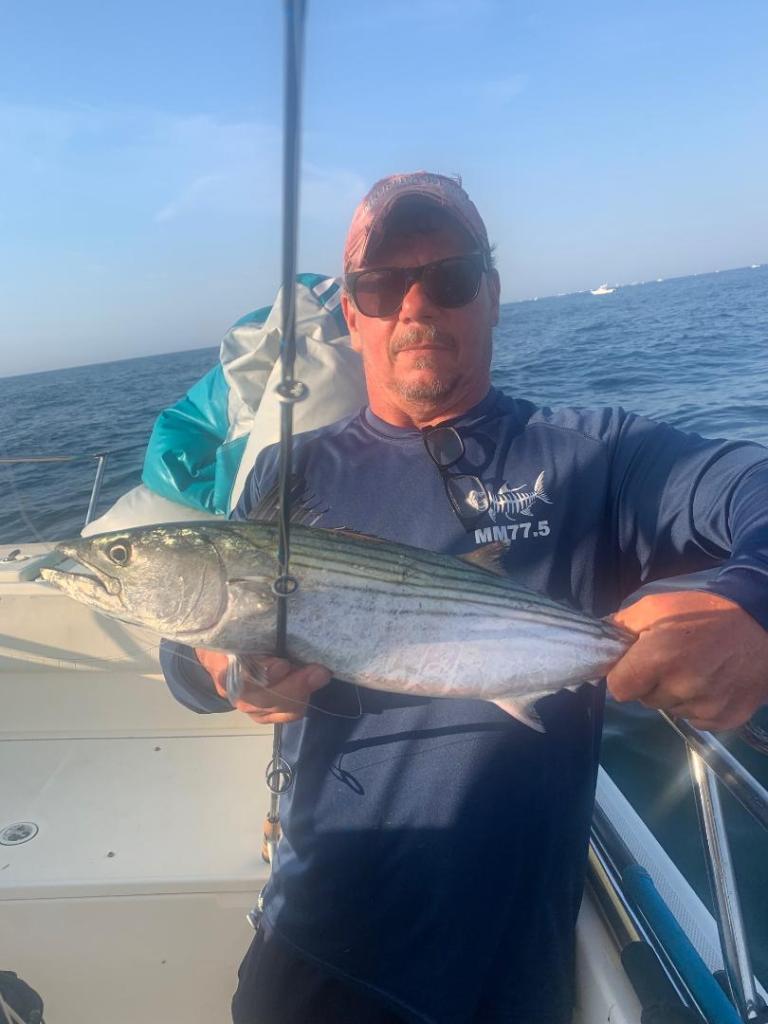Today is the last day of the 2022 NJ Summer Flounder Fishing Season but there’s a lot of great fishing going down. Here’s the fishing report update for the Long Beach Island area on Tuesday September 27, 2022.
Hi Flier Weakies and More
The bay fishing has been excellent. We are anchoring up and chumming with live grass shrimp. Catching anywhere from 7 to 10 different species, but the target is always weakfish. Lots of action on ultralite spinning gear. The water temperature dropped from 71.5 to 63 degrees in just a weeks time but the fish are still holding and aggressively hitting our bait and lures. Strike now while it’s hot. I am hoping we roll into mid October with this fishery but it’s always a wait and see.
The bluefish are still in good numbers at the inlet and are attacking the lures we are throwing, usually soft plastics. Mostly 2 to 4 pound fish, big enough to scream line off of our 10 pound spinning outfits.
We are catching big blowfish on the west side of the bay. Chumming with clam chum and using both clams and squid as hookbaits. There are enough jumbos to catch to let the small ones go. Fun to catch and delicious to eat!
Sailing every day for this mixed bag in the bay and inlet:
Tues thru Fri 10AM to 3PM
Sat, Sun, and Mon’s 7AM to Noon
The long range marine forecast looks good for Sat Oct 1 and Sun Oct 2 right now. It’s a little early to be planning offshore trips for those days but if they are right and the forecast holds up, we will be running Open Boat or Charter for tuna, bonita, albies…..whatever looks good. Stand by! Departure times will be somewhere around 5AM to 6AM and duration of the trip between 8 to 12 hours.
These dates are also available for the mixed bag bay charters.
Dave DeGennaro
Hi Flier Sportfishing
732.330.5674 cell

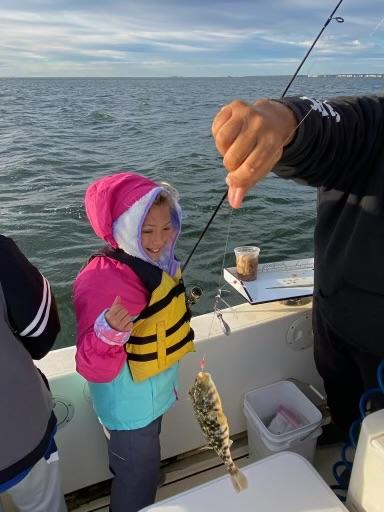


LBI Fishing Report 9/22/22
First Day of Fall Is Here! Personally my favorite time of year. With great weather, warm water, less crowded beaches and waterways topped off with great fishing opportunities (great surfing too) how can you not love early Fall? At the time of this post we have incoming long period swell from Hurricane Fiona which will be very powerful. It looks to peak Friday afternoon in the 6-10′ range. There will be windy NNW wind. This combo will make surf fishing difficult on Friday. The eastern section of Barnegat Inlet’s jetty could be treacherous! It should settle down significantly Saturday leaving as a beautiful yet chilly start to the day, low of 49º to start off the morning.
The bait really starts moving (mullet, peanut bunker, bay anchovies, sand eels, etc) and in the past week that has been very apparent. We’ve received some great videos and photos from customer capturing the bait and feeding frenzies. For some great photos check out our recent post on Instagram sharing Stay Above The Weather’s photographs of bait and active albies. In my most recent video report update (link below) I shared video from Neill McKenna. This past week we have received a couple deliveries of fresh surf caught mullet so the mullet run is progressing. We also got a report today from Bobby Capri, “There’s thousands of mullet but I did’t bring my cast net.” He did however get into great bass fishing plugging!
Fluke, small blues and a couple bass are in the surf. Remember NJ Fluke Fishing Season ends on 27th. Kingfish are on the suds too. Anglers at times also have a shot at albies.
Barnegat Inlet Jetty offers great fishing at this stage in the year. Tog, triggers and sheepshead as well as fluke, blues, striped bass. Yup a couple; drum too. In the bay there’s blowfish, weakfish, striped bass blues.
Jason Houck shared, “Thanks for the awesome reports. Stocked up this weekend and got in on some good fluke fishing off the beach on the north end and that epic bluefish blitz. That lasted a solid 2 hours on the north end and you could catch them at will for almost 4 hours.” Another report came in from XYZ.
Here’s my most recent video report…
Last weekend (9/18) was the America Anglers LBI Fishing Tournament. Here’s the abbreviated results… 36 teams and 20 individual anglers, 248 total anglers. Only 31 fish caught, the majority were bluefish with some kingfish and fluke peppered in.
| Results | Team Name | Total # Fish Points | Total # of Fish |
| 1st Place | OCFC Blue | 100.50 | 7 |
| 2nd Place | MFC C | 54.25 | 3 |
| 3rd Place | LBIFC A | 30.75 | 2 |
| 4th Place | The Bobbers | 30.00 | 2 |
| 5th Place | Surf and Land B | 25.75 | 2 |
| 6th Place | The Squad | 19.00 | 1 |
| 7th Place | Salty Sand Sharks | 18.75 | 1 |
| 8th Place | Team Speranza | 18.25 | 1 |
| 9th Place | Top Notch | 18.25 | 1 |
| 10th Place | Ocean County Boys | 18.00 | 1 |
Largest Fish MEN
| Results | Angler’s Name | Team | Species | Points(Length) Girth |
| 1st Place | Jeff Bajack | MFC C | F. Albacore | 23.50 |
| 2nd Place | Joja Cruz | The Squad | Other | 19.00 |
| 3rd Place | Andrew Basso | Salty Sand Sharks | Bluefish | 18.75 |
Largest Fish WOMEN
| Results | Angler’s Name | Team | Species | Points(Length) Girth |
| 1st Place | Katie Bailey | The Bobbers | Bluefish | 18.00 |
| 2nd Place | Sharon Zola | WSFC Red | Bluefish | 13.50 |
| 3rd Place | Heather Goldner | WSFC Blue | Bluefish | 12.00 |
Hi Flier Bay and Inlet Fishing
Barnegat Bay is on fire. We are consistently catching weakfish on all our live grass shrimping trips. If you have never tried this, it is something to see. Before each trip we pick up a large quantity of live grass shrimp. We head over to Barnegat Light, anchor up, and continuously throw over small handfuls of shrimp. Then we bait up our hooks and small jigs, really small, like 1/16 and 1/32 oz jigs, with shrimp. The hook gets loaded up with six or seven shrimp, the jigs only need two poked through the head. We are usually fishing in 10 to 15 feet of water. We pin the bobber a few feet less than the depth of the water from the baited hook, so if we are in 12 feet of water, we put the bobber 10 feet up from the hook. The jigs we drop straight down to the bottom or flip them out and slow retrieve them back to the boat. The weakies have been 12 to 17 inches. The variety you catch in the shrimp slick is what makes it so much fun. That, and the arsenal we use is made up of six pound spinning outfits, more akin to gear you would use on a trout stream. The variety of species we have been catching includes weakfish, fluke, kingfish, spots, blues, blowfish, hickory shad, sea robins, sand sharks, silver perch, croakers, blue runners and more. All spots become property of the Hi Flier, we pen them up for live bait for tuna and stripers.
We are also anchoring up on the west side of the bay and hammering away at jumbo blowfish. They are fun to catch and delicious to eat!I”ll clean the first 20, the rest you take whole.
The inlet has been giving up 2 to 4 pound blues very consistently. We are casting soft plastics on 3/8 oz jigheads. We have not been getting any bass in the mix recently but they will start soon. We keep it light with this fishery, too, 10 pound spinning outfits.
It is possible to combine any or all of these fisheries in a single trip. It’s all peaking right now, so strike while the iron is hot. It should roll into the first or second week of October if recent history is any indication. The messy weather coming is the perfect time to try this fishery. We fish in very protected water. 20 to 25 knots of wind is no problem.
Available for charter Tues thru Fri 10AM to 3PM or Sat, Sun, and Mon’s 7AM to Noon. When the weather and sea condition relents we will start running offshore again. Until then, this exciting Plan B becomes Plan A!










Dave DeGennaro
Hi Flier Sportfishing
732.330.5674 cell
LBI Fishing Report 9/13/22
The weekend’s tropical groundswell for the most past has faded down to a 1-3′ wave lingering on the beaches. The ocean energy will be down for the next few days, but it is topical swell season so keep an eye on things.
In recent days anglers have taken advantage of the variety on tap. There’s opportunities for just about everyone from surf and jetty to inshore and offshore fishing.
On the surf anglers are catching fluke, kingfish and blues. I saw a few peanut bunker and mullet in the surf on the south end on Saturday and Monday. There were also turns present and a couple had small bait in their beaks. This had to have been spearing or sand eels. As per Sept 1 report there are sand eels around. The mullet are moving and now coming down off the full moon (Saturday) I expect the mullet to pick up strong and hopefully run into October.
On the jetty anglers are catching tog, fluke, blues and striped bass. Trigger and sheepshead are also present at times. Fishing crabs (greens, mole) is best for tog, triggers and sheeps. Casting lures (poppers, swimmers, jigs) you’ll get into bass and blues at the right times. Jig and teaser tipped with Gulp is the receipt for fluke.
In the bay blowfish, fluke and weakfish are best targets. Blues and bass are also options, both of which should offer progressively more action in the coming weeks.
Inshore fluke fishing will be strong throughout the rest of the season (Sept 27th). Albies, bonito and Spanish mackerel are in the nearshore waters. Mahi are also surprisingly close in. Cobia is another species here too.
Offshore yellowfin, bluefin tuna fishing is very good at times. Deep dropping for sword and tilefish is also a solid option.
Hi Flier Bluefin
I love tuna fishing! Just had to get that out of the way. When the fish are there and we can catch them on bait and jigs, I don’t know if there is any fishery more exciting. I especially love day chunking on the midrange grounds. That’s exactly what we did on Monday, Labor Day. Headed north to chase a report that my first mate (and son) received from his friend at 4AM as we were leaving the slip. Got to the spot early, had good bait and fish readings, but the first runoff did not come until 9:30AM. I set the circle hook up and he screamed line for 10 seconds and then came unbuttoned. We reeled in an empty hook. Sucks, but really the only acceptable loss in the fishing game. Everything else is human error. Ten minutes later, the same rod goes off, a flatlined sardine, and this time we stay stuck. Twenty minutes later a 60 pound bluefin hits the deck. Over the next few hours we went four for six on 40 to 60 pound fish, all on bait, except for one that hit Chris Mace’s jig, christening his new spinning outfit that was made for the task. Caught them all on our AVET LX arsenal instead of the big gold reels. So much more fun on the 30 class conventionals. We started with 30 lb flouro leader but bumped up to 40 as they were so aggressive. When we cut the fish at the dock, they had our chunks in them, so that justified that effort. Of course the weather is going to prevent us from returning anytime soon but we are all hoping that they stay put for a while. This northeast should push even nicer water in. Here is a clip of Igor Sapiga decking that first bluefin: https://www.youtube.com/watch?v=0NQ7O1Pdyno
We are still hammering away at the weakfish and the ultralite buffet in Barnegat Bay. Wed, Thurs, and Fri’s 10AM to 3PM.
The bonita and albacore reports are also very strong so we will be running those trips, as well. Trolling to find them and then setting up a spearing slick to chum them up and catch them on spinning tackle.
My head is spinning right now from the choices. This is a great time of year coming up.
Dave DeGennaro
Hi Flier Sportfishing
732.330.5674 cell



Hi Flier Open Boat Tuna Monday Labor Day
Running Open Boat Tuna this Monday, Labor Day, Sept 5, 3AM to 5PM. Good chance we will mix in Tilefish and Mahi where we are headed. $450 person, 4 people max, all fish are shared. Call to reserve a spot, phone is better than text or email.
I cancelled our Saturday trip last night as that NE wind did not drop out early enough to make for a good sea condition. Monday looks like it will be really nice. The boats we network with caught big yellowfin there yesterday and we will have the benefit of information from all the boats sailing Sunday.
Tues Sept 6 and Wed Sept 7 we are available for charter only to fish for weakfish and a bunch of other species on ultralite tackle in the bay 10AM to 3PM.
Dave DeGennaro
Hi Flier Sportfishing
732.330.5674 cell
LBI’s Fishing Report – Sept 1st
Time flies when you are having fun! So far this summer has been a great one. We had some good weather and good fishing. Hopefully everyone enjoys this Labor Day Weekend and the late summer fishing. We have a nice weekend ahead with conditions looking prime. Let’s go fishing! Here’s the Fishing Report Update for the Long Beach Island Area on Labor Day Weekend.
Before diving into the fishing report I must first share a couple fishing events…
Save The Dates!
This Saturday Sept 4th is the 2nd Annual “Rock The Dock” Fluke Tournament – Registration is live now online at https://www.njfishingclub.com/rockthedock. For the full rules and details, click here. Last year’s inaugural event was a success and it was built upon and made even better this year having a dual gun shot start (conveniently having one on the north end and one on the south end) and weigh ins via water or land at The Boatyard right on the LBI Causeway. This tournament is open to boat anglers, kayak anglers, surf/land based AND there’s spots open with Captain Sammy on the Mary M charter boat out of Barnegat Light. Sammy is always on the fish and last year Jake Bayak got the second place overall heaviest fluke as well as the Mary M Calcutta. For 2021 results… https://www.njfishingclub.com/rock-the-dock-results.
The 68th LBI Fall Classic Surf Fishing Tournament kicks off October 8th and runs to December 11th. Registration has begun, $30. Stop by and sign up today!
LBI Fishing Report Details
Warm water and great weather coupled with a large variety of target species from both the beach or boat makes late summer one of the best times to fish the waters of LBI. Here’s what’s happening on and around Long Beach Island.
LBI Surf Fishing Report
To kick off the month of September, the LBI Surf Temp is 73º as per the Harvey Cedars Beach Patrol.
In recent days on the surf fluke, kingfish and spot as well as at times blues offered fun fishing for surf anglers. With the warm clean water surf anglers could see a couple croakers, puppy drum and possibly a pompano. A variety is available to catch fishing a small hooked hi/lo rig baited with live bloodworms, live sand fleas, Fish Bites or DynaBait.
Steve George shared that he had some sand eels on the beach when fluke fishing Monday. It’s not a bad idea to start fishing “fall style” teasers to match the slender baits!

With the warm surf temps there’s also rays and sharks. All summer long they are cruising the Jersey Shore but right now could be the peak. There’s black tips, spinners, sandbars, sand tigers and yesterday we heard of a tiger shark (NOT sand tiger) which caught and released off the Sea Isla beach.
Barnegat Bay Fishing Report
The local waters have an abundance of bait and the Mullet Run is right around the corner!
Back bay anglers are still catching good numbers of fluke drifting the main channels working out towards the Inlet. Blowfishing is and has been great. Blow toads offer great light tackle fun on the water and they are good eats too. Anchor up in the open Barnegat Bay and put down a clam chum log. Fish a simple small hook rig, baited with clam, squid or our favorite because it stays on the hook great… Fish Bites! Don’t hesitate to thread on a piece of Fish Bites and then top off with a piece of clam, squid or a morsel of Gulp. Gotta save those short bit off baits for this purpose.
Weakfish are here in good numbers and if you know when and where to look they have been for most of the summer. This is the time when shrimping weakies is a ton of fun! Land based anglers are catching under the lights at night.
This time of year offers some of the best crabbing and it is also a great time to go clamming!
Barnegat Inlet Jetty Fishing Report
All summer the Jetty offers great fishing opportunities! Casting small plugs and jigs you’ll find cocktail (1-3# class) bluefish and possibly some hardtail species like Spanish mackerel, bonita and albies. Fishing baited rigs you’ll catch tog and the occasional triggerfish and sheepshead. There’s always resident striped bass roaming too. There’s a lot of bait in and around the inlet almost daily. As the days get shorter and the water cools expect to see even more exiting the bay. Then we should see more activity with striped bass and sometimes a couple larger blues. Later in September and October offer great fun fishing for these two species as well as TOG!
Central NJ Ocean Fishing Report
Inshore / Near Shore Fishing: Ocean fluke fishing has been good and it should remain good right to the end of the season, Sept 27th. Reports from the reef sites as well as wrecks and open bottom have been good. Action has been productive on the open bottom off of Island Beach State Park and LBI, 30-50′ (some are catching drifting in closer to the beach too) fishing the lumps and old clam beds that striped bass anglers fish all fall. The local party boat, Miss Barnegat Light has had happy customers on recent trips with good catches of fluke and some days mackerel in the mix. The past two days they reported, “Really good day of fluking. Everyone went home with dinner.” And. “Great day fluking. Quit wishin’ and go fishin’!” They are sailing right now but after Labor Day Weekend they will be shifting gears to tuna canyon trips so be sure to call the boat to confirm their schedule.
Remember NJ Black Sea Bass Fishing is closed as of Sept 1.
Today we got a delivery of fresh bunker and our local boat shared he saw some foamers on the way in. That’s right… hardtails hammering bait pods. He said were albies and bonita. Both species have been around these parts as well as Spanish mackerel. There’s a surprisingly strong showing of dorado (mahi mahi) around the inshore waters. We got some mahi reports from from fluke anglers fishing the reefs.
Midshore / Offshore Fishing: Now’s a great time to be offshore. With the summer waning down there’s less boats now than during the heat of July and August. And fishing at times has been really good. We’ve heard some good catch reports of yellowfin, bluefin, swordfish and tilefish. Reports of both day troll and night chunk as well as deep drop action both day and night. Harry on the Parrot Dice reported on his last trip he chunked up some yellowfin and also caught a small but legal (keeper size) sword. Today we got a report from Capt Mark on the Bluerunner, “Found some yellowfin on the troll, chunk and jig. Then added a 75″ bigeye to finish off the trip. Also had some mahi.” Word is the Magictail 3oz HooMagic Heads did the pretty work and then the crew down down and down the dirty work.
Mahi seem to be everywhere and some big ones too! A nice one was weighed in by Austin Pounds on Monday. There’s a good showing of wahoo. Most are catching them by accident but there are some high speed trollers focusing on them.

Summer Surf Fluke Fishing is Not Over Yet !
It may be the unofficial end of Summer here on the Island after this Labor Day Weekend. 🏖
But the Summer Fluke Fishing will continue to be very good at times well towards the end of the month, NJ Summer Flounder Season Closes 9/27/22.
Still some really nice “overs” to be found if you work for them 😉 and with the success of the “slot fish” regulations now on the table this year there are still some great opportunities to catch some table fare 👍
Add in the pending “Mullet Run” with all that baitfish heading Out of the Bay – Thru the Inlet – and Down the Beach plus with a little help from Mother Nature it could be a September to Remember 👍
EVERYONE Have a Great / Fun /Safe Holiday – Happy Labor Day – Catch’em Up 🎣
*Stay Tuned for News about some “Fall Run” Surf Trips I have planned to close out the year here on LBI.
Nightstrikes Surfcasting Guide Service LLC / Steve George call 609-276-6983

Hi Flier Weakfish and Open Boat Tuna
So our bonita/albacore trip sucked last week. Ran 26 miles north to where the bite had been good for a few weeks just to hear the “What happened?” chatter on the radio. We eeked out one nice bonita on bait and that was that. The only good thing that happened was I broke in one of the six new Fish Head rods I just acquired from Fishermans Headquarters on that fish, and they are awesome! Flexible enough to enjoy the fight but has enough backbone to control the fish. Love them! Paired with 5000 spinning reels, these are going to be our “everything” outfits. Bonita, albies, mahi, stripers, blues and anything else that shows up.
We are crushing the weakfish and big blowfish in Barnegat Bay. All on six pound ultralite rods. The weakies are ranging from 11 to 18 inches, with most in the 13 to 15 inch range. We are available for your private charter for these trips Fri Sept 2, 5, 6, and 7.
We have been laying low on the tuna trips because, frankly, we were not scoring. It’s been a tricky season. SO, I do what most boats in my size class do (25 ft), we wait and watch the marine weather, and wait, and watch, sometimes we watch and wait, and then BAM! The weather window is there and I have some good intel from a friend who just got back from a good yellowfin trip. So we are headed east in search of the bite. Should be mostly bait and jigs. I will have the trolling gear on board but I am hoping not to use it unless we are scouting. Saturday Sept 3, 3AM to 5PM, $450 person, 4 people max, all fish are shared. We need to fill all 4 spots to sail. The boat is also available for charter for this day, but only for tuna. I need a shot of blue water once and a while to stay sane. Saturday is that day. Call to reserve a spot, that is the best way to get me.
Hope to see you on board,
Dave
Dave DeGennaro
Hi Flier Sportfishing
732.330.5674 cell

Pic: Billy Fellows of Absecon NJ with a nice bonita
